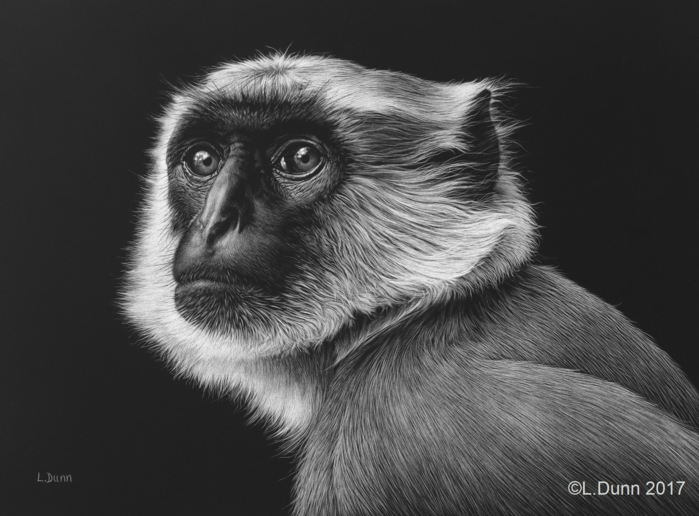LORI DUNN SCRATCHBOARD ART
promoting conservation through artistic efforts
The Sacred Eyes Of Delhi
8 x 10
SOLD
I have always thought that the group of old world monkeys known as "langurs" were some of the most beautiful of all the primate species. Langurs are known for their highly arboreal nature, long tails and slender bodies. Primarily leaf eaters, they also get much of their nutrition from fruit, flowers and seeds. The particular species depicted here is the "Grey" or "Hanuman" langur (Semnopithecus dussumieri). Ranging throughout South Asia, but primarily India, it has adapted to a wide variety of habitats, and unlike it's mostly arboreal cousins, it spends a good deal of time on the ground.
In Hindu culture, the Hanuman langur is revered. It is a symbol of the monkey deity "Hanuman", whose simian army helped to rescue the god Rama's wife, Sita, from a demon king. In India, the langurs are afforded privileges unreserved for other animals - they are allowed to roam and eat freely among the people, and are regularly fed by them. The same is not true for the Rhesus monkey. Considered a nuisance, some 30,000 of them roam in and around Delhi. They are destructive, bite people, break into buildings and cars, and steal everything they can grab, whether it is food or not.
Despite the langur's delicate appearance, they sport some serious canines, are much larger than Rhesus monkeys, and will attack them with little provocation. The Hanuman langur, for these reasons, has been used by many people of the city to chase off unwanted Rhesus monkeys. Handlers raise them and train them, much as you would a guard dog. In the past, this has proved to be big business for the handlers who are regularly employed to use their trained langurs to guard government buildings or large public events. Unfortunately, this is not a good gig for the langur. Kept leashed and isolated from other langurs, the practice is considered abusive to these highly social primates who normally exist in family groups.
Deforestation, logging and hunting has caused a severe decline of all langur species in the last 20 years. Many are now endangered or threatened with extinction. In 2012 the Environment ministry cracked down, declaring that Hanuman langurs are covered by India’s Wildlife Protection Act, and that people who own, trade or hire out langurs face up to three years in jail. Despite this decree, business is still available for langur handlers, who continue to operate in secret, relying on the black market wildlife trade.
